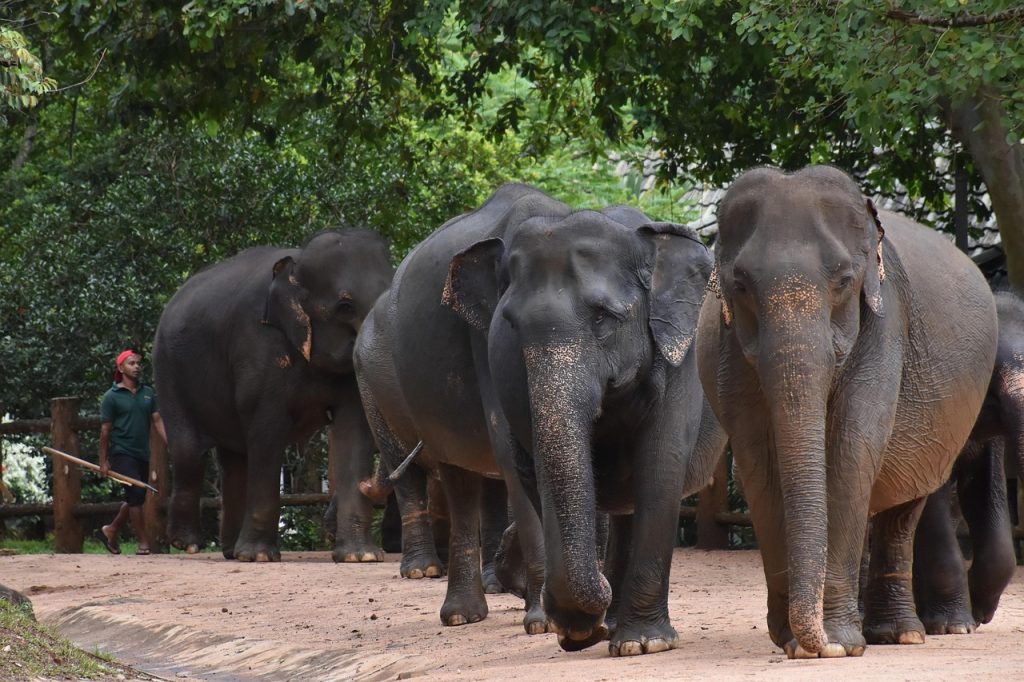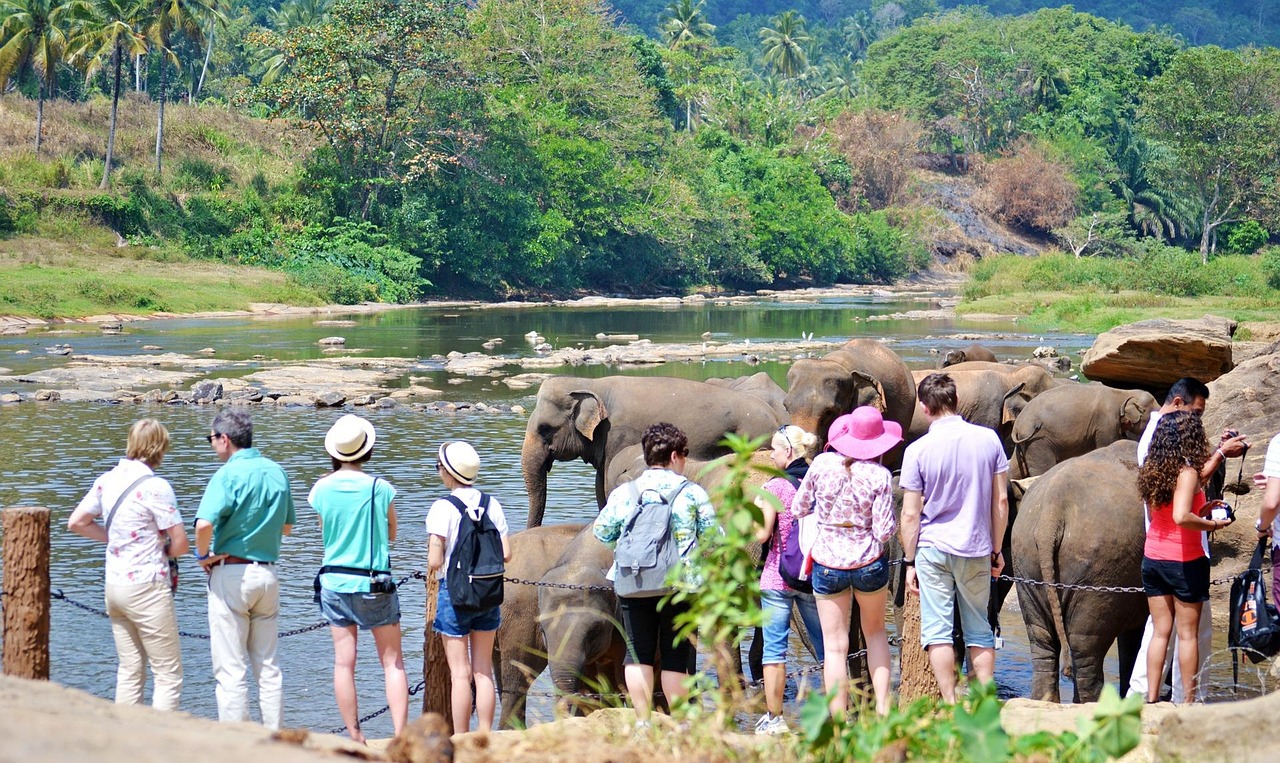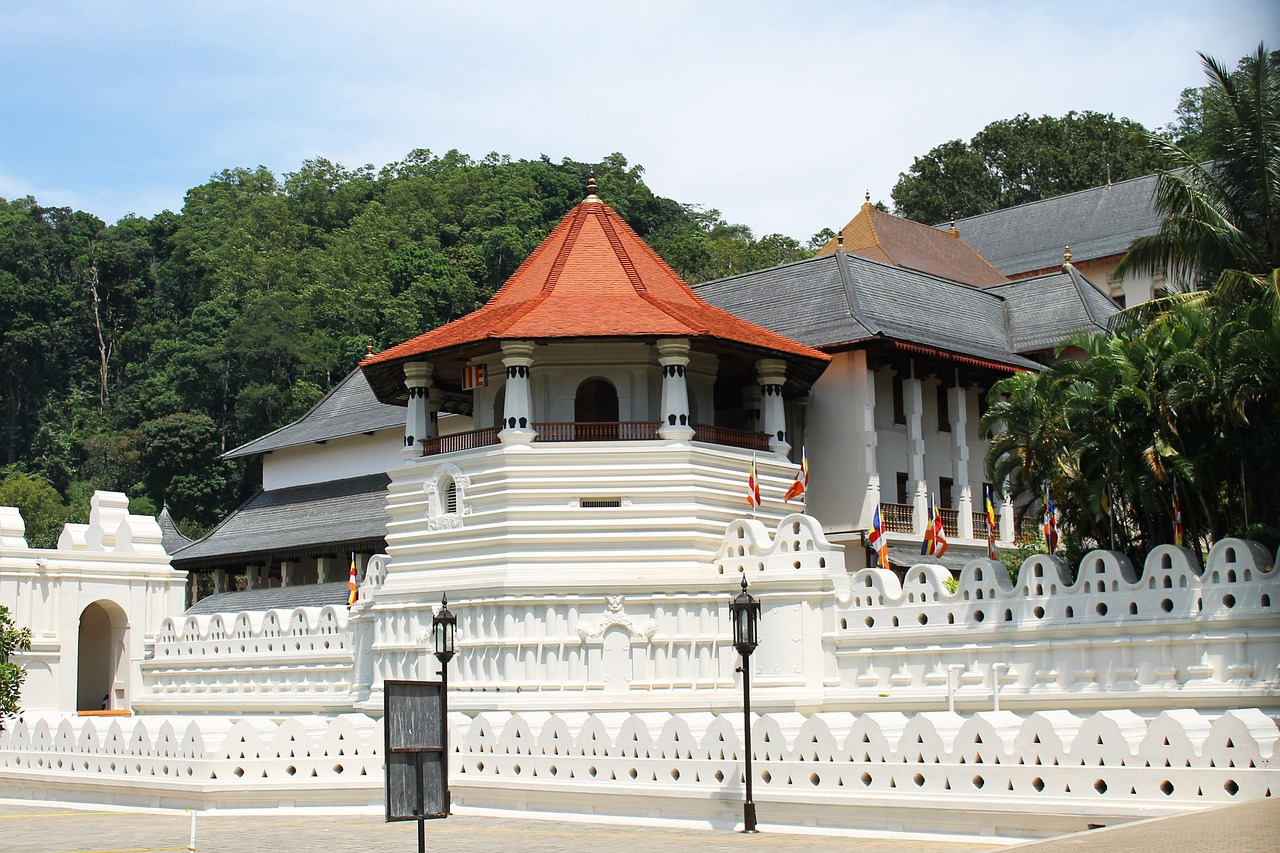In the verdant hills of Sri Lanka‘s Sabaragamuwa Province, nestled along the banks of the Ma Oya River, lies one of the world’s most remarkable wildlife sanctuaries. The Pinnawala Elephant Orphanage stands as a testament to human compassion and conservation efforts, providing refuge to orphaned, injured, and abandoned elephants while offering visitors an unprecedented opportunity to witness these magnificent creatures in a semi-natural environment. Pinnawala Elephant Orphanage Sri Lanka.
The Genesis of a Dream – Pinnawala Elephant Orphanage Sri Lanka
sri lankaThe story of Pinnawala Elephant Orphanage begins in 1975, when the Sri Lankan Department of Wildlife Conservation established this unique facility with a singular mission: to care for orphaned elephant calves found in the wild. What started as a modest initiative to protect a handful of vulnerable baby elephants has evolved into one of the most successful elephant breeding and conservation programs in the world.
The orphanage was born out of necessity. Sri Lanka’s rapid development and expanding human settlements had increasingly encroached upon elephant habitats, leading to more frequent human-elephant conflicts. Young elephants, separated from their herds due to various circumstances including poaching, habitat destruction, or accidents, needed immediate care and protection. Traditional wildlife reserves, while excellent for established herds, weren’t equipped to provide the intensive care required by infant elephants who would typically depend on their mothers and extended family groups for survival.
The location chosen for this sanctuary was particularly strategic. Pinnawala, a small town approximately 90 kilometers northeast of Colombo, offered the perfect combination of accessibility for visitors and staff, while providing the natural environment necessary for elephant welfare. The proximity to the Ma Oya River proved especially crucial, as it allowed for one of the orphanage’s most distinctive features: daily river baths that would become both a vital part of elephant care and a spectacular attraction for visitors worldwide.
A Growing Family
From its humble beginnings with just five orphaned calves, Pinnawala has grown exponentially. Today, the facility houses over 80 elephants, making it home to the largest captive herd of elephants in the world. This remarkable growth is not merely due to rescue operations; it’s also a testament to the successful breeding program that has become central to the orphanage’s mission.
The elephant population at Pinnawala represents multiple generations, with some residents being second and even third-generation orphanage-born elephants. This multi-generational approach has created a unique social dynamic that closely mimics natural elephant family structures. Older females take on matriarchal roles, guiding and protecting younger members of the herd, while bulls maintain their own social hierarchies and relationships.
Each elephant at Pinnawala has its own story, name, and personality. From elderly matriarchs who have spent decades at the facility to playful calves born within the sanctuary’s boundaries, every resident contributes to the complex social fabric that makes this place so extraordinary. The staff, many of whom have worked at the orphanage for decades, know each elephant individually, understanding their preferences, health needs, and behavioral patterns with remarkable precision.
Daily Life at the Sanctuary

Life at Pinnawala follows a carefully structured routine designed to meet both the physical and psychological needs of its residents. The day begins early, around 6:00 AM, with the morning feeding. Elephants consume enormous quantities of food – an adult can eat up to 300 kilograms of vegetation daily – so feeding times are significant undertakings that require careful planning and execution.
The orphanage sources food from various locations, including specially cultivated elephant grass, coconut leaves, and branches from approved trees. Younger elephants receive milk formula, carefully prepared to match the nutritional content of elephant milk as closely as possible. The feeding process itself is a spectacle, with elephants demonstrating their individual eating habits and preferences while mahouts (elephant keepers) ensure each animal receives adequate nutrition.
Perhaps the most iconic aspect of daily life at Pinnawala is the twice-daily journey to the Ma Oya River for bathing and drinking. These processions, occurring around 10:00 AM and 2:00 PM, have become legendary among wildlife enthusiasts and photographers. Watching 80-plus elephants make their way down the dusty path to the river, with babies staying close to their mothers and older elephants moving at their own measured pace, provides visitors with an almost surreal experience of witnessing a mini-migration.
At the river, elephants engage in behaviors that are both practical and joyful. They drink deeply, spray water over their bodies to cool down and protect against insects, and engage in social interactions that strengthen herd bonds. Young elephants play in the shallow areas while adults wade deeper, sometimes completely submerging themselves. The sight of baby elephants learning to use their trunks properly while splashing in the water never fails to captivate observers.
Conservation Through Education
Beyond its primary role as a sanctuary, Pinnawala serves as an invaluable educational resource. The facility welcomes hundreds of thousands of visitors annually, from local school children to international researchers and tourists. This educational aspect is crucial to the broader conservation mission, as it helps people understand the challenges facing Asian elephants and the importance of protecting their natural habitats.
The orphanage offers various educational programs tailored to different audiences. School groups participate in structured learning experiences that teach children about elephant biology, behavior, and conservation needs. These programs often include interactive sessions where children can observe elephant feeding, learn about the different tools and techniques used in elephant care, and understand the broader ecological role that elephants play in their natural environments.
For international visitors, Pinnawala provides a unique opportunity to observe elephant behavior up close while learning about the specific challenges facing Asian elephants. Unlike African elephants, Asian elephants face more severe habitat pressure due to higher human population density in their range countries. The stories of individual elephants at Pinnawala help visitors understand these broader conservation challenges in personal, relatable terms.
The facility also serves as a research center, with scientists and researchers from around the world studying elephant behavior, reproduction, health, and social dynamics. This research contributes valuable data to the global understanding of elephant biology and informs conservation strategies both in Sri Lanka and internationally.
Breeding Success and Its Significance
One of Pinnawala’s most remarkable achievements has been its success in elephant breeding. Asian elephants have historically been challenging to breed in captivity, with low birth rates and high infant mortality making population sustainability difficult. Pinnawala has overcome many of these challenges, with dozens of successful births contributing to both the facility’s population and the broader genetic diversity of Asian elephants.
The breeding program operates on principles that prioritize elephant welfare and natural behaviors. Rather than forcing breeding through artificial means, the facility allows elephants to form natural social bonds and mating relationships. This approach has not only been more successful in terms of conception and birth rates but has also resulted in healthier, more behaviorally normal offspring.
Each birth at Pinnawala is cause for celebration, not just for the immediate joy of welcoming a new life, but for the broader conservation implications. Every healthy elephant born at the facility represents hope for the species’ future and demonstrates that with proper care and conditions, Asian elephants can thrive in human care while maintaining their natural behaviors and social structures.
The facility maintains detailed records of all births, tracking genetic lines and ensuring healthy breeding diversity. This data is shared with other elephant conservation programs worldwide, contributing to global efforts to maintain viable elephant populations both in captivity and in the wild.
Challenges and Criticisms
Like many wildlife facilities that balance conservation with public access, Pinnawala has faced its share of challenges and criticisms. Animal welfare advocates have raised questions about various aspects of the facility’s operations, from the use of chains to restrain elephants during certain times to the large numbers of visitors that can create stressful environments for the animals.
The orphanage has worked continuously to address these concerns while maintaining its dual mission of elephant care and public education. Improvements over the years have included enhanced enclosures, modified visitor access protocols, and updated animal management practices that prioritize elephant welfare while still allowing for the educational and conservation benefits that visitor programs provide.
One ongoing challenge is balancing the facility’s role as a tourist attraction with its conservation mission. The revenue generated from visitor fees is crucial for funding elephant care, but large crowds can potentially create stress for the animals. The facility has implemented various measures to manage this balance, including visitor number limitations during certain times, designated viewing areas that maintain appropriate distances, and educational programs that help visitors understand appropriate behavior around elephants.
The Broader Conservation Context
Pinnawala’s work must be understood within the broader context of Asian elephant conservation. Asian elephants are classified as endangered, with populations declining due to habitat loss, human-elephant conflict, and poaching. Sri Lanka is home to one of the largest remaining Asian elephant populations, but even here, the challenges are significant.
The orphanage serves multiple roles in addressing these challenges. Most directly, it provides care for elephants that would otherwise likely perish in the wild. But perhaps more importantly, it serves as an ambassador program, helping people understand and value elephants in ways that support broader conservation efforts.
Many visitors to Pinnawala leave with a deeper appreciation for elephants and a better understanding of the conservation challenges they face. This educational impact extends far beyond Sri Lanka, as international visitors return to their home countries with enhanced awareness and often become advocates for elephant conservation in their own communities.
The facility also serves as a model for other elephant care programs in Asia. The techniques developed at Pinnawala for feeding, medical care, and social management have been shared with other facilities, contributing to improved elephant welfare across the region.
Economic Impact and Community Benefits
The Pinnawala Elephant Orphanage has become one of Sri Lanka’s most popular tourist destinations, generating significant economic benefits for the local community and the broader region. Hotels, restaurants, souvenir shops, and transportation services have all developed around the facility, creating employment opportunities and contributing to local economic development.
This economic impact extends the conservation benefits of the facility beyond direct elephant care. When local communities benefit economically from elephant conservation, they become stakeholders in protecting elephants and their habitats. This community engagement is crucial for long-term conservation success, as it helps reduce human-elephant conflict and builds local support for conservation initiatives.
The facility also employs dozens of local residents as mahouts, maintenance staff, administrators, and in visitor services. Many of these employees have developed specialized skills in elephant care that make them valuable contributors to conservation efforts throughout Sri Lanka and beyond.
Visitor Experience and What to Expect
For visitors, a trip to Pinnawala offers an unforgettable experience that combines wildlife observation, education, and emotional connection. The facility is designed to maximize visitor engagement while prioritizing elephant welfare, creating opportunities for meaningful interactions with these remarkable animals.
The highlight for most visitors is witnessing the river bathing sessions. The sight of dozens of elephants moving as a group toward the water, with babies playfully interacting with adults and the entire herd engaging in natural bathing behaviors, provides photo opportunities and memories that last a lifetime. The best viewing spots along the riverbank offer excellent vantage points while maintaining appropriate distances for both visitor safety and elephant comfort.
Feeding times also provide spectacular viewing opportunities. Watching elephants use their trunks with incredible dexterity to manipulate food, observing the social hierarchies that determine feeding order, and seeing the care that mothers provide to their young offers insights into elephant intelligence and social complexity that few other venues can provide.
The facility includes a museum and information center that provides context for the orphanage’s work and broader elephant conservation issues. Visitors can learn about elephant biology, the history of the facility, individual elephant stories, and the broader conservation challenges facing Asian elephants.
Future Directions and Evolving Mission
As Pinnawala approaches its sixth decade of operation, its mission continues to evolve in response to changing conservation needs and advancing understanding of elephant welfare. Current initiatives include habitat expansion projects that will provide elephants with more space and more naturalistic environments, enhanced veterinary facilities to support the health of the growing population, and expanded research programs that will contribute to global elephant conservation knowledge.
The facility is also working to strengthen its connections with in-situ conservation programs – efforts to protect elephants in their natural habitats. This includes supporting anti-poaching efforts, habitat restoration projects, and community-based conservation programs that address human-elephant conflict.
Technology is playing an increasingly important role in the facility’s operations and mission. GPS tracking systems help monitor elephant movements and behavior, advanced veterinary equipment supports health care, and digital platforms help share research findings and educational content with global audiences.
Conclusion: A Legacy of Compassion and Conservation
The Pinnawala Elephant Orphanage represents far more than a tourist attraction or even a wildlife sanctuary. It stands as a symbol of what can be achieved when human compassion meets scientific understanding and conservation commitment. From its modest beginnings with five orphaned calves to its current status as home to the world’s largest captive elephant herd, Pinnawala has demonstrated that with proper care, resources, and dedication, humans can make a positive difference in the lives of endangered species.
The facility’s success in elephant breeding, its contributions to scientific understanding of elephant behavior and biology, and its role in educating millions of visitors about conservation issues have established it as a model for wildlife conservation programs worldwide. But perhaps most importantly, Pinnawala has given hope – hope for the future of Asian elephants, hope for the possibility of humans and wildlife coexisting, and hope that individual actions can contribute to broader conservation success.
As visitors watch baby elephants splash in the Ma Oya River under the watchful eyes of their adoptive mothers, or observe the complex social interactions that make elephant society so fascinating, they become part of a larger story of conservation and compassion. The Pinnawala Elephant Orphanage reminds us that every individual life matters, that conservation efforts can succeed with proper support and commitment, and that the bonds between humans and wildlife can be both meaningful and mutually beneficial.
In a world where wildlife faces unprecedented challenges, Pinnawala stands as a beacon of hope, demonstrating that with dedication, resources, and community support, we can create positive outcomes for endangered species. The orphanage’s legacy extends far beyond its boundaries, inspiring similar efforts worldwide and contributing to a global movement toward more effective and compassionate wildlife conservation.
The gentle giants of Pinnawala, from the elderly matriarchs who remember the facility’s early days to the newest calves taking their first tentative steps toward the river, carry with them the hopes and dreams of everyone who believes that humans and wildlife can share this planet in harmony. Their story is one of resilience, adaptation, and the transformative power of human compassion – a story that continues to unfold with each new day at this remarkable sanctuary.


